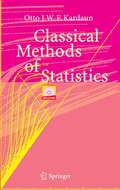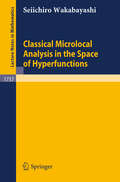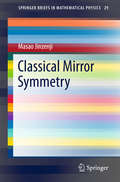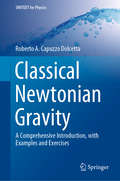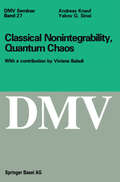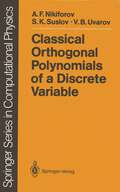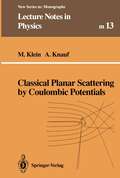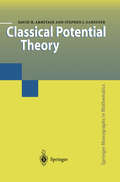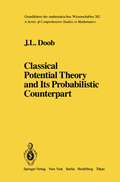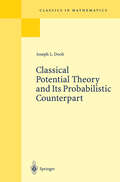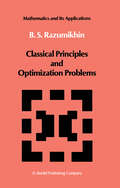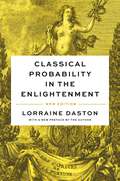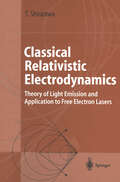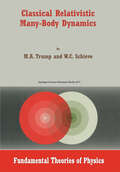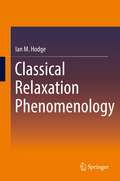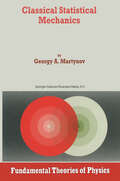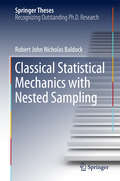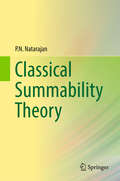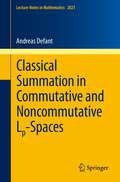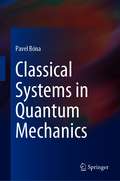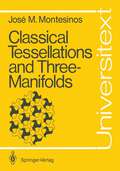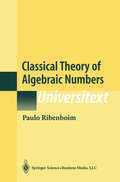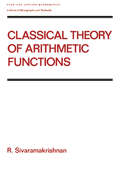- Table View
- List View
Classical Methods of Statistics: With Applications in Fusion-Oriented Plasma Physics
by Otto J.W.F. KardaunClassical Methods of Statistics is a guidebook combining theory and practical methods. It is especially conceived for graduate students and scientists who are interested in the applications of statistical methods to plasma physics. Thus it provides also concise information on experimental aspects of fusion-oriented plasma physics. In view of the first three basic chapters it can be fruitfully used by students majoring in probability theory and statistics. The first part deals with the mathematical foundation and framework of the subject. Some attention is given to the historical background. Exercises are added to help readers understand the underlying concepts. In the second part, two major case studies are presented which exemplify the areas of discriminant analysis and multivariate profile analysis, respectively. To introduce these case studies, an outline is provided of the context of magnetic plasma fusion research. In the third part an overview is given of statistical software; separate attention is devoted to SAS and S-PLUS. The final chapter presents several datasets and gives a description of their physical setting. Most of these datasets were assembled at the ASDEX Upgrade Tokamak. All of them are accompanied by exercises in form of guided (minor) case studies. The book concludes with translations of key concepts into several languages.
Classical Microlocal Analysis in the Space of Hyperfunctions (Lecture Notes in Mathematics #1737)
by Seiichiro WakabayashiThe book develops "Classical Microlocal Analysis" in the spaces of hyperfunctions and microfunctions, which makes it possible to apply the methods in the distribution category to the studies on partial differential equations in the hyperfunction category. Here "Classical Microlocal Analysis" means that it does not use "Algebraic Analysis." The main tool in the text is, in some sense, integration by parts. The studies on microlocal uniqueness, analytic hypoellipticity and local solvability are reduced to the problems to derive energy estimates (or a priori estimates). The author assumes basic understanding of theory of pseudodifferential operators in the distribution category.
Classical Mirror Symmetry (SpringerBriefs in Mathematical Physics #29)
by Masao JinzenjiThis book furnishes a brief introduction to classical mirror symmetry, a term that denotes the process of computing Gromov–Witten invariants of a Calabi–Yau threefold by using the Picard–Fuchs differential equation of period integrals of its mirror Calabi–Yau threefold. The book concentrates on the best-known example, the quintic hypersurface in 4-dimensional projective space, and its mirror manifold.First, there is a brief review of the process of discovery of mirror symmetry and the striking result proposed in the celebrated paper by Candelas and his collaborators. Next, some elementary results of complex manifolds and Chern classes needed for study of mirror symmetry are explained. Then the topological sigma models, the A-model and the B-model, are introduced. The classical mirror symmetry hypothesis is explained as the equivalence between the correlation function of the A-model of a quintic hyper-surface and that of the B-model of its mirror manifold.On the B-model side, the process of construction of a pair of mirror Calabi–Yau threefold using toric geometry is briefly explained. Also given are detailed explanations of the derivation of the Picard–Fuchs differential equation of the period integrals and on the process of deriving the instanton expansion of the A-model Yukawa coupling based on the mirror symmetry hypothesis.On the A-model side, the moduli space of degree d quasimaps from CP^1 with two marked points to CP^4 is introduced, with reconstruction of the period integrals used in the B-model side as generating functions of the intersection numbers of the moduli space. Lastly, a mathematical justification for the process of the B-model computation from the point of view of the geometry of the moduli space of quasimaps is given.The style of description is between that of mathematics and physics, with the assumption that readers have standard graduate student backgrounds in both disciplines.
Classical Newtonian Gravity: A Comprehensive Introduction, with Examples and Exercises (UNITEXT for Physics)
by Roberto A. Capuzzo DolcettaThis textbook offers a readily comprehensible introduction to classical Newtonian gravitation, which is fundamental for an understanding of classical mechanics and is particularly relevant to Astrophysics. The opening chapter recalls essential elements of vectorial calculus, especially to provide the formalism used in subsequent chapters. In chapter two Classical Newtonian gravity theory for one point mass and for a generic number N of point masses is then presented and discussed. The theory for point masses is naturally extended to the continuous case. The third chapter addresses the paradigmatic case of spherical symmetry in the mass density distribution (central force), with introduction of the useful tool of qualitative treatment of motion. Subsequent chapters discuss the general case of non-symmetric mass density distribution and develop classical potential theory, with elements of harmonic theory, which is essential to understand the potential development in series of the gravitational potential, the subject of the fourth chapter. Finally, in the last chapter the specific case of motion of a satellite around the earth is considered. Examples and exercises are presented throughout the book to clarify aspects of the theory. The book is aimed at those who wish to progress further beyond an initial bachelor degree, onward to a master degree, and a PhD. It is also a valuable resource for postgraduates and active researchers in the field.
Classical Nonintegrability, Quantum Chaos (Oberwolfach Seminars #27)
by Andreas Knauf Yakov G. SinaiOur DMV Seminar on 'Classical Nonintegrability, Quantum Chaos' intended to introduce students and beginning researchers to the techniques applied in nonin tegrable classical and quantum dynamics. Several of these lectures are collected in this volume. The basic phenomenon of nonlinear dynamics is mixing in phase space, lead ing to a positive dynamical entropy and a loss of information about the initial state. The nonlinear motion in phase space gives rise to a linear action on phase space functions which in the case of iterated maps is given by a so-called transfer operator. Good mixing rates lead to a spectral gap for this operator. Similar to the use made of the Riemann zeta function in the investigation of the prime numbers, dynamical zeta functions are now being applied in nonlinear dynamics. In Chapter 2 V. Baladi first introduces dynamical zeta functions and transfer operators, illustrating and motivating these notions with a simple one-dimensional dynamical system. Then she presents a commented list of useful references, helping the newcomer to enter smoothly into this fast-developing field of research. Chapter 3 on irregular scattering and Chapter 4 on quantum chaos by A. Knauf deal with solutions of the Hamilton and the Schr6dinger equation. Scatter ing by a potential force tends to be irregular if three or more scattering centres are present, and a typical phenomenon is the occurrence of a Cantor set of bounded orbits. The presence of this set influences those scattering orbits which come close.
Classical Orthogonal Polynomials of a Discrete Variable (Scientific Computation)
by Arnold F. Nikiforov Sergei K. Suslov Vasilii B. UvarovClassical Planar Scattering by Coulombic Potentials (Lecture Notes in Physics Monographs #13)
by Markus Klein Andreas KnaufAstronomy as well as molecular physics describe non-relativistic motion by an interaction of the same form: By Newton's respectively by Coulomb's potential. But whereas the fundamental laws of motion thus have a simple form, the n-body problem withstood (for n > 2) all attempts of an explicit solution. Indeed, the studies of Poincare at the end of the last century lead to the conclusion that such an explicit solution should be impossible. Poincare himselfopened a new epoch for rational mechanics by asking qual itative questions like the one about the stability of the solar system. To a largeextent, his work, which was critical for the formation of differential geometry and topology, was motivated by problems arising in the analysis of the n-body problem ([38], p. 183). As it turned out, even by confining oneselfto questions ofqualitativenature, the general n-body problem could not be solved. Rather, simplified models were treated, like planar motion or the restricted 3-body problem, where the motion of a test particle did not influence the other two bodies.
Classical Potential Theory (Springer Monographs in Mathematics)
by David H. Armitage Stephen J. GardinerA long-awaited, updated introductory text by the world leaders in potential theory. This essential reference work covers all aspects of this major field of mathematical research, from basic theory and exercises to more advanced topological ideas. The largely self-contained presentation makes it basically accessible to graduate students.
Classical Potential Theory and Its Probabilistic Counterpart: Advanced Problems (Grundlehren der mathematischen Wissenschaften #262)
by J. L. DoobPotential theory and certain aspects of probability theory are intimately related, perhaps most obviously in that the transition function determining a Markov process can be used to define the Green function of a potential theory. Thus it is possible to define and develop many potential theoretic concepts probabilistically, a procedure potential theorists observe withjaun diced eyes in view of the fact that now as in the past their subject provides the motivation for much of Markov process theory. However that may be it is clear that certain concepts in potential theory correspond closely to concepts in probability theory, specifically to concepts in martingale theory. For example, superharmonic functions correspond to supermartingales. More specifically: the Fatou type boundary limit theorems in potential theory correspond to supermartingale convergence theorems; the limit properties of monotone sequences of superharmonic functions correspond surprisingly closely to limit properties of monotone sequences of super martingales; certain positive superharmonic functions [supermartingales] are called "potentials," have associated measures in their respective theories and are subject to domination principles (inequalities) involving the supports of those measures; in each theory there is a reduction operation whose properties are the same in the two theories and these reductions induce sweeping (balayage) of the measures associated with potentials, and so on.
Classical Potential Theory and Its Probabilistic Counterpart (Classics in Mathematics)
by Joseph L. DoobFrom the reviews: "Here is a momumental work by Doob, one of the masters, in which Part 1 develops the potential theory associated with Laplace's equation and the heat equation, and Part 2 develops those parts (martingales and Brownian motion) of stochastic process theory which are closely related to Part 1". --G.E.H. Reuter in Short Book Reviews (1985)
Classical Principles and Optimization Problems (Mathematics and its Applications #15)
by B.S. RazumikhinApproach your problems from the right end It isn't that they can't see the solution. It is and begin with the answers. Then one day, tbat they can't see the problem. perbaps you will find the fina\ question. G. K. Chesterton. The Scandal of Father 'The Hermit Clad in Crane Feathers' in R. Brown 'The point of a Pin'. van GuJik's The Chinese Maze Murders. Growing specialization and diversification have brought a host of monographs and textbooks on increasingly specialized topics. However, the "tree" of knowledge of mathematics and related fields does not grow only by putting forth new branches. It also happens, quite often in fact, that branches which were thought to be completely disparate are suddenly seen to be related. Further, the kind and level of sophistication of mathematics applied in various sciences has changed drastically in recent years: measure theory is used (non-trivially) in regional and theoretical economics; algebraic geometry interacts with physics; the Minkowsky lemma, coding theory and the structure of water meet one another in packing and covering theory; quantum fields, crystal defects and mathematical programming profit from homotopy theory; Lie algebras are relevant to filtering; and prediction and electrical engineering can use Stein spaces. And in addition to this there are such newemerging subdisciplines as "experimental mathematics", "CFD", "completely integrable systems", "chaos, synergetics and large-scale order", which are almost impossible to fit into the existing classification schemes. They draw upon widely different sections of mathematics.
Classical Probability in the Enlightenment, New Edition
by Lorraine DastonAn award-winning history of the Enlightenment quest to devise a mathematical model of rationalityWhat did it mean to be reasonable in the Age of Reason? Enlightenment mathematicians such as Blaise Pascal, Jakob Bernoulli, and Pierre Simon Laplace sought to answer this question, laboring over a theory of rational decision, action, and belief under conditions of uncertainty. Lorraine Daston brings to life their debates and philosophical arguments, charting the development and application of probability theory by some of the greatest thinkers of the age. Now with an incisive new preface, Classical Probability in the Enlightenment traces the emergence of new kind of mathematics designed to turn good sense into a reasonable calculus.
Classical Probability in the Enlightenment, New Edition
by Lorraine DastonAn award-winning history of the Enlightenment quest to devise a mathematical model of rationalityWhat did it mean to be reasonable in the Age of Reason? Enlightenment mathematicians such as Blaise Pascal, Jakob Bernoulli, and Pierre Simon Laplace sought to answer this question, laboring over a theory of rational decision, action, and belief under conditions of uncertainty. Lorraine Daston brings to life their debates and philosophical arguments, charting the development and application of probability theory by some of the greatest thinkers of the age. Now with an incisive new preface, Classical Probability in the Enlightenment traces the emergence of new kind of mathematics designed to turn good sense into a reasonable calculus.
Classical Relativistic Electrodynamics: Theory of Light Emission and Application to Free Electron Lasers (Advanced Texts in Physics)
by Toshiyuki ShiozawaAn advanced course of classical electrodynamics with application to the generation of high-power coherent radiation in the microwave to optical-wave regions. Specifically, it provides readers with the basics of advanced electromagnetic theory and relativistic electrodynamics, guiding them step by step through the theory of free-electron lasers. The theoretical treatment throughout this book is fully developed by means of the usual three-dimensional vector calculus.
Classical Relativistic Many-Body Dynamics (Fundamental Theories of Physics #103)
by M.A. Trump W.C. Schievein this work, we must therefore assume several abstract concepts that hardly need defending at this point in the history of mechanics. Most notably, these include the concept of the point particle and the concept of the inertial observer. The study of the relativistic particle system is undertaken here by means of a particular classical theory, which also exists on the quantum level, and which is especially suited to the many-body system in flat spacetime. In its fundamental postulates, the theory may be consid ered to be primarily the work of E.C.G. Stiickelberg in the 1940's, and of L.P. Horwitz and C. Piron in the 1970's, who may be said to have provided the generalization of Stiickelberg's theory to the many-body system. The references for these works may be found in Chapter 1. The theory itself may be legitimately called off-shell Hamiltonian dynamics, parameterized relativistic mechanics, or even classical event dynamics. The most important feature of the theory is probably the use of an invariant world time parameter, usually denoted T, which provides an evolution time for the system in such as way as to allow manifest co variance within a Hamiltonian formalism. In general, this parameter is neither a Lorentz-frame time, nor the proper time of the particles in the system.
Classical Relaxation Phenomenology
by Ian M. HodgeThis book serves as a self-contained reference source for engineers, materials scientists, and physicists with an interest in relaxation phenomena. It is made accessible to students and those new to the field by the inclusion of both elementary and advanced math techniques, as well as chapter opening summaries that cover relevant background information and enhance the book's pedagogical value. These summaries cover a wide gamut from elementary to advanced topics.The book is divided into three parts. The opening part, on mathematics, presents the core techniques and approaches. Parts II and III then apply the mathematics to electrical relaxation and structural relaxation, respectively. Part II discusses relaxation of polarization at both constant electric field (dielectric relaxation) and constant displacement (conductivity relaxation), topics that are not often discussed together. Part III primarily discusses enthalpy relaxation of amorphous materials within and below the glass transition temperature range. It takes a practical approach inspired by applied mathematics in which detailed rigorous proofs are eschewed in favor of describing practical tools that are useful to scientists and engineers. Derivations are however given when these provide physical insight and/or connections to other material.A self-contained reference on relaxation phenomenaDetails both the mathematical basis and applicationsFor engineers, materials scientists, and physicists
Classical Statistical Mechanics (Fundamental Theories of Physics #89)
by G.A. MartynovStatistical mechanics deals with systems in which chaos and randomness reign supreme. The current theory is therefore firmly based on the equations of classical mechanics and the postulates of probability theory. This volume seeks to present a unified account of classical mechanical statistics, rather than a collection of unconnected reviews on recent results. To help achieve this, one element is emphasised which integrates various parts of the prevailing theory into a coherent whole. This is the hierarchy of the BBGKY equations, which enables a relationship to be established between the Gibbs theory, the liquid theory, and the theory of nonequilibrium phenomena. As the main focus is on the complex theoretical subject matter, attention to applications is kept to a minimum. The book is divided into three parts. The first part describes the fundamentals of the theory, embracing chaos in dynamic systems and distribution functions of dynamic systems. Thermodynamic equilibrium, dealing with Gibbs statistical mechanics and the statistical mechanics of liquids, forms the second part. Lastly, the third part concentrates on kinetics, and the theory of nonequilibrium gases and liquids in particular. Audience: This book will be of interest to graduate students and researchers whose work involves thermophysics, theory of surface phenomena, theory of chemical reactions, physical chemistry and biophysics.
Classical Statistical Mechanics with Nested Sampling (Springer Theses)
by Robert John BaldockThis thesis develops a nested sampling algorithm into a black box tool for directly calculating the partition function, and thus the complete phase diagram of a material, from the interatomic potential energy function. It represents a significant step forward in our ability to accurately describe the finite temperature properties of materials. In principle, the macroscopic phases of matter are related to the microscopic interactions of atoms by statistical mechanics and the partition function. In practice, direct calculation of the partition function has proved infeasible for realistic models of atomic interactions, even with modern atomistic simulation methods. The thesis also shows how the output of nested sampling calculations can be processed to calculate the complete PVT (pressure–volume–temperature) equation of state for a material, and applies the nested sampling algorithm to calculate the pressure–temperature phase diagrams of aluminium and a model binary alloy.
Classical Summability Theory
by P. N. NatarajanThis book presents results about certain summability methods, such as the Abel method, the Norlund method, the Weighted mean method, the Euler method and the Natarajan method, which have not appeared in many standard books. It proves a few results on the Cauchy multiplication of certain summable series and some product theorems. It also proves a number of Steinhaus type theorems. In addition, it introduces a new definition of convergence of a double sequence and double series and proves the Silverman-Toeplitz theorem for four-dimensional infinite matrices, as well as Schur's and Steinhaus theorems for four-dimensional infinite matrices. The Norlund method, the Weighted mean method and the Natarajan method for double sequences are also discussed in the context of the new definition. Divided into six chapters, the book supplements the material already discussed in G.H.Hardy's Divergent Series. It appeals to young researchers and experienced mathematicians who wish to explore new areas in Summability Theory..
Classical Summation in Commutative and Noncommutative Lp-Spaces (Lecture Notes in Mathematics #2021)
by Andreas DefantThe aim of this research is to develop a systematic scheme that makes it possible to transform important parts of the by now classical theory of summation of general orthonormal series into a similar theory for series in noncommutative $L_p$-spaces constructed over a noncommutative measure space (a von Neumann algebra of operators acting on a Hilbert space together with a faithful normal state on this algebra).
Classical Systems in Quantum Mechanics
by Pavel BónaThis book investigates two possibilities for describing classical-mechanical physical systems along with their Hamiltonian dynamics in the framework of quantum mechanics.The first possibility consists in exploiting the geometrical properties of the set of quantum pure states of "microsystems" and of the Lie groups characterizing the specific classical system. The second approach is to consider quantal systems of a large number of interacting subsystems – i.e. macrosystems, so as to study the quantum mechanics of an infinite number of degrees of freedom and to look for the behaviour of their collective variables. The final chapter contains some solvable models of “quantum measurement" describing dynamical transitions from "microsystems" to "macrosystems".
Classical Tessellations and Three-Manifolds (Universitext)
by José María Montesinos-AmilibiaThis unusual book, richly illustrated with 29 colour illustrations and about 200 line drawings, explores the relationship between classical tessellations and three-manifolds. In his original and entertaining style, the author provides graduate students with a source of geometrical insight into low-dimensional topology. Researchers in this field will find here an account of a theory that is on the one hand known to them but here is "clothed in a different garb" and can be used as a source for seminars on low-dimensional topology, or for preparing independent study projects for students, or again as the basis of a reading course.
Classical Theory of Algebraic Numbers (Universitext)
by Paulo RibenboimThe exposition of the classical theory of algebraic numbers is clear and thorough, and there is a large number of exercises as well as worked out numerical examples. A careful study of this book will provide a solid background to the learning of more recent topics.
Classical Theory of Arithmetic Functions (Chapman And Hall/crc Pure And Applied Mathematics Ser. #126)
by R SivaramakrishnanThis volume focuses on the classical theory of number-theoretic functions emphasizing algebraic and multiplicative techniques. It contains many structure theorems basic to the study of arithmetic functions, including several previously unpublished proofs. The author is head of the Dept. of Mathemati
Classical Theory of Arithmetic Functions (Chapman And Hall/crc Pure And Applied Mathematics Ser.)
by R SivaramakrishnanThis volume focuses on the classical theory of number-theoretic functions emphasizing algebraic and multiplicative techniques. It contains many structure theorems basic to the study of arithmetic functions, including several previously unpublished proofs. The author is head of the Dept. of Mathemati
